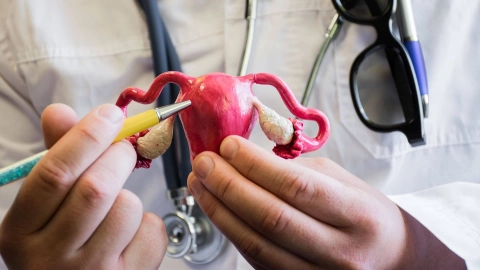Conditions Excessive hair growth (hypertrichosis)
ICD codes: L68 What are ICD codes?
Unusually excessive hair growth is called hypertrichosis. The excessive hair growth can occur on the whole body or only in certain areas, and can be congenital or acquired. For treatment, it is important to identify the cause.
At a glance
- Hypertrichosis is excessive hair growth, occurring either on the entire body or in a specific area.
- The cause of this can be congenital or acquired, i.e. develop after birth.
- Medication often causes acquired hypertrichosis.
- If the cause of hypertrichosis can be found and eliminated, the hair growth usually recedes.
- Laser treatments or epilation – removal of hair by the roots – are options for permanent hair removal.
Note: The information in this article cannot and should not replace a medical consultation and must not be used for self-diagnosis or treatment.

What is hypertrichosis?
Hypertrichosis is a term for excessive hair growth that can occur in individual areas or on the entire body. It can be congenital or only develop in the course of a lifetime.
A distinction is made between three types of hair: soft, downy hair typical of infants (lanugo), light, soft and downy vellus hair and thick, adult terminal hair such as grows on the head, in the armpits or in the genital region.
With hypertrichosis lanuginosa congenita, a congenital form of hypertrichosis, the hairiness is at its most noticeable, because it affects the whole body.
How does hypertrichosis manifest itself?
Excessive hair growth can affect the entire body. In that case, it is called generalized hypertrichosis. If the increased hair growth only occurs in certain areas, it is called localized hypertrichosis.
The excessive hair growth can have different appearances:
- If the hair is thick and resembles the hair on the head, under the arms or in the genital region, it is called terminal hair.
- If the hair is light, soft and downy, it is called vellus hair.
- Lanugo hair actually grows on unborn babies’ skin, protecting it from being softened by the amniotic fluid in the womb. It is normally replaced by vellus hair within a few weeks after the birth. However, it can regrow, for instance as a result of certain cancers.
Among the areas of the body that can have increased hairiness due to congenital localized hypertrichosis are the forearms and cubital fossa (elbow pit), the palms, the soles of the feet, the auricles, the tip of the nose, and the front and rear of the neck.
With congenital hypertrichosis lanuginosa, the entire body is covered with up to 10 centimeters of long fine silver-gray to blond lanugo. In addition, other symptoms include dental anomalies, pyloric stenosis (narrowing of the opening from the stomach into the small intestine) or eye conditions.
Hypertrichosis on the whole body can also appear as excessive “normal” hairiness, thus with increased terminal hair on the back, arms, legs and around the ears.
If hypertrichosis develops because of defective genetic information, it sometimes occurs in the form of a syndrome along with other typical signs of disease or deformities.
Depending on what caused the hypertrichosis, the increased hair growth is noticeable in various areas and at various times.
What are the causes of hypertrichosis?
There are various causes of hypertrichosis, depending on the type of excessive hair growth.
Hypertrichosis on the entire body
With the rare hereditary syndromes that accompany this form of excessive hair growth, the development of hair follicles is often abnormal. If hypertrichosis occurs in children before puberty, an increased amount of the sex hormone testosterone may be the reason.
If hypertrichosis develops in the course of a lifetime, medication is often the cause, for example:
- antibiotics such as streptomycin
- anti-inflammatory drugs like cortisone
- the active substance acetazolamide: a diuretic drug
- the active substance phenytoin: an anti-epileptic drug
- the active substances cyclosporine and mycophenolate mofetil: drugs that suppress the immune system (immunosuppressives)
If the excessive hairiness consists of fine lanugo that normally only appears in infants, it may have been caused by cancer – usually lung or bowel cancer.
Localized hypertrichosis
Congenital moles are often extremely hairy. Localized hypertrichosis also occurs with rare congenital deformities such as Cornelia de Lange syndrome or Rubinstein-Taybi syndrome.
Furthermore, repeated injuries, chafe marks or inflammation can cause increased hairiness. For example, many workers who often put strain on their backs develop hypertrichosis on the back. After a limb is put in plaster, it is also possible for pressure sores to react with increased hair formation.
How is hypertrichosis diagnosed?
Hypertrichosis is easy to recognize by the excessive hair growth.
Initially, it is necessary to establish whether it is congenital or acquired. For this purpose, the doctor asks various questions, for instance about the family history and medication being taken.
In the next step, the predominant hair type is determined. During the physical examination, the doctor also pays attention to other deformities or accompanying symptoms.
If a rare, congenital syndrome is suspected, genetic, neurological and other examinations may follow. If cancer is suspected to have caused the excessive hair growth, other examinations also follow, for instance ultrasound, X-ray or computed tomography (CT).
How is hypertrichosis treated?
From a purely medical standpoint, hypertrichosis does not require any treatment.
There are people whose excessive body hair does not affect their lives but those who feel uncomfortable with it can remove the unwanted hair with various methods.
The simplest and fastest involve the application of hair removal creams but these remove the hair without its roots, so it quickly grows back. Moreover, the creams often cause skin irritation.
Specialist laser treatment is the most effective means of permanent hair removal. Another method is electrolysis. This removes hair by its roots. For proper use, it is also advisable to contact a specialist.
If hypertrichosis has occurred as a side effect of a drug, the hair growth usually recedes when the drug is discontinued. Other cases of acquired hypertrichosis usually abate if the cause can be eliminated.
If the hypertrichosis is congenital, it usually lasts a lifetime and can be passed down to children. If the excessive hair growth is noticeable and easily visible, it can be very emotionally debilitating. Psychological care and support may then be considered.
- Saleh D, Yarrarapu SNS, Cook C. Hypertrichosis. [Updated 2021 July 23]. In: StatPearls [Internet]. Treasure Island (FL): StatPearls Publishing; 2021 Jan-. Aufgerufen am 04.02.2022.
In cooperation with the Institute for Quality and Efficiency in Health Care (Institut für Qualität und Wirtschaftlichkeit im Gesundheitswesen – IQWiG).
As at:





